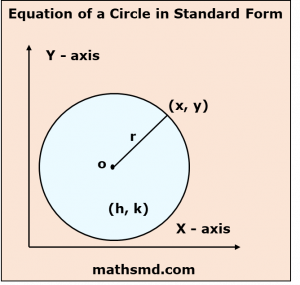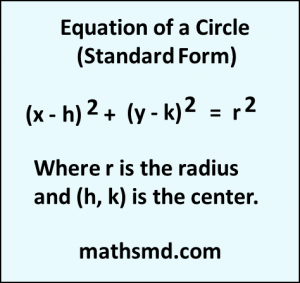Standard Form Equation For a Circle
Equation of a Circle – Standard Form
In this tutorial we will discuss what is an equation of a circle formula in standard form and find the equation of a circle with examples.
The equation of a circle in standard form is a mathematical representation that describes all the points (x, y) that are equidistant from a fixed point called the center of the circle.
What is the equation of the Circle?
First we know what is a circle ?
A circle is a set of all points which are equally distance from a fixed point in a plane.
The fixes point is called the center of the circle. The distance between any point on the circumference is called the radius of the circle.

An equation of a circle represents the position of a circle in Cartesian plane.
If we know the coordinates of the center of the circle and the length of its radius, we can write the equation of the circle. The equation of the circle represents all points that lie on the circumference of the circle. The standard form of equation of a circle is easier to understand and read.
Standard Form of a circle A circle without touching any axis of the two dimensional cartesian coordinate system is a standard equation is called the equation of a circle in standard form.

The standard form of equation of a circle is given by
(x – h)² + ( y – k)² = r²
Where (h, k) is the coordinates of the circle and r is radius and (x, y) is the arbitrary coordinates on the circumference of the circle.
This is the standard form of the equation. thus if we know the radius and coordinates of the center of the circle we can easily find its equation.
Example: Point (2, 3) is the center of the circle and radius is equal to 5 cm.
Then the equation of the circle will be:
(x – 2)² + (y – 3)² = 5²
(x² – 4x + 4) + (y² – 6y + 9) = 25
x² + y² – 4x – 6y + 4 + 9 = 25
x² + y² – 4x – 6y + 13 = 25
x² + y² – 4x – 6y = 25 – 13
x² + y² – 4x – 6y = 12
x² + y² – 4x – 6y – 12 = 0
which is called the standard form for the equation of a circle.
Distance Formula:
The equation (x – h)² + (y – k)² = r² is derived from the distance formula in coordinate geometry. The distance between any point (x, y) on the circle and the center (h, k) must always be r.
According to the distance formula, the distance d between two points (x1, y1) and (x2, y2) is
d = ✓{(x2−x1)² + (y2 – y1)²}
For a circle, the distance d between any point (x, y) on the circle and the center (h, k) is equal to the radius r:
r = ✓{(x−h)2+(y−k)2}
For a circle, the distance d between any point (x, y) on the circle and the center (h,k) is equal to the radius r:
r= ✓{(x−h)2+(y−k)2}
Squaring both sides of this equation to eliminate the square root gives:
r2 = (x−h)2+(y−k)2
This is the standard form of the equation of a circle.
Example
Consider a circle with a center at (3,−2) and a radius of 5. The standard form equation for this circle is:
(x−3)2 + (y+2)2 = 52
Simplifying this, we get:
(x−3)2 + (y+2)2= 25
General Form of the Equation of a Circle
Sometimes, the equation of a circle might be given in a different form, known as the general form:
Ax2 + Ay2 + Dx + Ey + F=0
Here, A, D ,E, and F are constants. This form can be converted to the standard form by completing the square on the x and y terms.
Completing the Square
To convert the general form to the standard form, follow these steps:
Group the x terms and y terms together.
Factor out the coefficient of x2 and y2, if it is not 1.
Complete the square for the x terms and the y terms.
Adjust the equation to match the standard form.
Example Conversion
Given the general form equation
x2+y2−6x+4y−12=0
Group x and y terms:
(x2−6x)+(y2+4y)=12
Complete the square for x and y:
For x-terms: x2−6x
Take half of −6, which is −3, and square it to get 9.
x2−6x+9−9
For y-terms: y2 + 4y
Take half of 4, which is 2, and square it to get 4.
y2 + 4y + 4 − 4
Add these squares to both sides of the equation:
(x2−6x+9)+(y2+4y+4)=12+9+4
(x−3)2+(y+2)2=25
Now, the equation is in the standard form with the center (3,−2) and radius 5.
Summary
The standard form of the equation of a circle is a concise way to describe all points equidistant from a central point. It is crucial for various applications in geometry, physics, engineering, and computer graphics. Understanding how to derive and manipulate this form allows for a deeper comprehension of the properties and behaviors of circles.